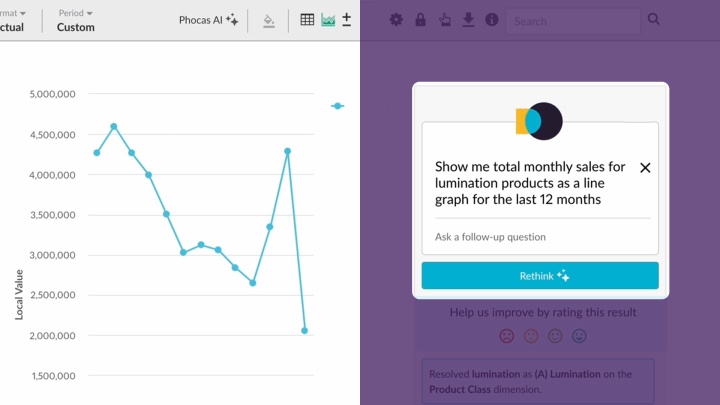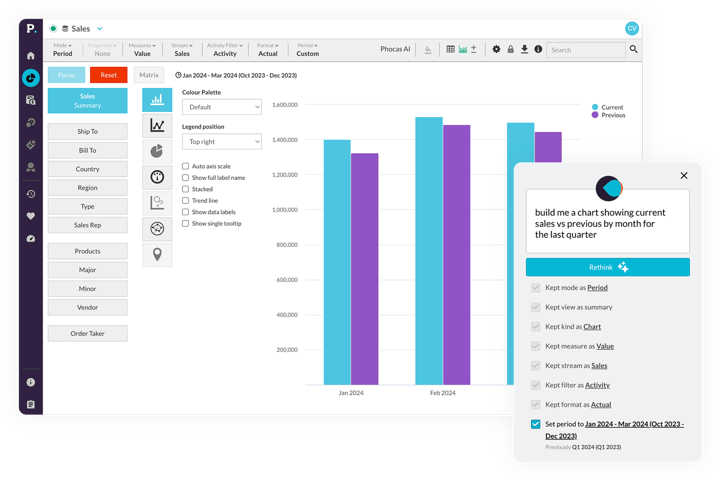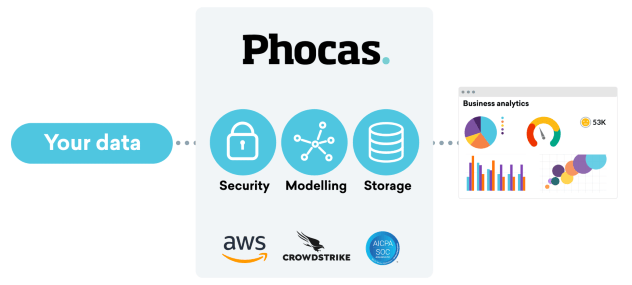Now you can fast-track data analytics with Phocas AI.
Quick, obligation free

AI simplifies BI for everyone
- All databases built in Phocas Analytics are AI-ready
- Query your data by branch, division, sales, product, customer or performance
- From CFO to intern, everyone can understand and improve your business at any level
- Phocas AI gives people the confidence to ask questions about their work.

Turbo-charge the way you do analytics

No tech jargon, just plain language
- Phocas AI uses a natural language processing (NLP) model helping to fast-track data access
- Sales, purchasing, inventory and finance teams can ask questions written in plain language without navigating databases
- No waiting for IT or data analysts - if you're on a sales call, you can get quick answers independently
- Phocas AI is unique in that it shows the steps taken to answer queries
- Learn as you go and use AI to bolster your ability to navigate and interrogate databases.

Your data remains secure within Phocas
- Phocas AI seamlessly integrates with all your data - sales, operational, purchasing; and digs into it securely
- Your transactional data remains securely within the Phocas environment - nothing is shared externally
- The Phocas platform provides a secure end-to-end solution, partnering with AWS and CrowdStrike security to follow industry best practice
- Phocas continually meets industry best practice with Security and Privacy compliance for SOC 2 Type 2 and GDPR.

Frequently asked questions
AI-powered analytics refers to the application of artificial intelligence (AI) techniques and technologies to analyze large volumes of data and derive valuable insights. Traditional analytics methods often involve manual data processing and analysis, which can be time-consuming and may not fully leverage the potential insights hidden within the data.
AI-powered analytics, on the other hand, utilizes machine learning algorithms, natural language processing (NLP), deep learning, and other AI techniques to automate and enhance the analytics process. This allows organizations to extract meaningful patterns, trends, correlations, and predictions from their data in a more efficient and accurate manner.
Some common applications of AI-powered analytics include:
Predictive analytics: Using machine learning algorithms to forecast future trends or outcomes based on historical data.
Prescriptive analytics: Recommending actions or decisions based on insights derived from data analysis.
Natural language processing (NLP) for text analytics: Analyzing unstructured text data such as customer feedback, social media posts, or emails to extract insights and sentiment.
Image and video analytics: Leveraging computer vision techniques to analyze images and videos for various purposes, such as object recognition, facial recognition, or anomaly detection.
Advanced data visualization: Using AI algorithms to generate interactive and dynamic visualizations that help users explore and understand complex datasets more effectively.
Improved data accuracy: AI algorithms can help clean and normalize data, reducing errors and inconsistencies within datasets and improving data integrity. This enhances the accuracy and reliability of insights derived from BI software.
Faster insights: AI-powered analytics can process large volumes of data much faster than traditional methods, enabling users to gain insights in near real-time.
Advanced analytics: AI enables more sophisticated analytics techniques, such as predictive analytics, allowing organizations to forecast future trends, identify patterns, and make data-driven business decisions.
Enhanced data visualization: AI can automate the creation of interactive and intuitive data visualizations, making it easier for users to explore and understand complex datasets.
Personalized insights: AI algorithms can analyze individual user behavior and preferences to deliver personalized insights and recommendations tailored to specific user needs.
Task automation: AI can automate repetitive tasks such as data preparation, report generation, and anomaly detection, freeing up analysts' time to focus on insight generation, risk management and more strategic decision making.
Improved decision-making: By providing timely, accurate, and actionable insights, AI-powered BI software empowers decision-makers at all levels of the organization to make informed decisions that drive business growth and competitiveness.
Scalability: AI-powered BI software can scale to handle increasing volumes and complexity of data without sacrificing performance or accuracy. This scalability is essential for organizations experiencing rapid growth or dealing with big data challenges.
Continuous learning and optimization: AI algorithms can learn from user interactions and feedback to continuously improve their performance and relevance.
Natural Language Processing (NLP): Phocas AI uses a NLP model that allows people to ask questions in plain language. The AI system then interprets and generates relevant insights or visualizations, saving non-experts from having to configure the data themselves.
Guided Analytics: Once a query is answered, Phocas AI also reveals the breadcrumbs of how it arrived at the result. Enabling users to understand the data analysis process.
Automated Data Preparation: AI algorithms automate data cleaning, transformation, and preparation, which are typically complex and time-consuming for non-experts. This enables users to work with clean, consolidated data without having to rely on data experts.
Interactive Visualizations: Interactive data visualizations allow users to explore data intuitively through interactive charts, graphs, and dashboards. Non-experts can interact with visualizations to gain insights and identify trends without needing to understand complex statistical techniques.
To ensure the safety of your data within an AI-powered platform you should thoroughly vet your chosen software provider, paying particular attention to the following security practices:
Data Encryption and Security Measures: Robust encryption techniques and security measures should be employed to protect your data from unauthorized access. All data transferred to and stored within the Phocas Cloud is encrypted using industry-recognized methods. When using Phocas AI, transactional data remains securely within the Phocas environment - nothing is shared externally.
Data Protection Regulations: Ensure that your provider complies with relevant data protection regulations such as GDPR (General Data Protection Regulation) in Europe. Phocas invests heavily in GDPR, Privacy Shield, and stringent privacy safeguards to keep your data private and under your control.
Compliance and Certification: Regular audits and assessments ensure that security and privacy standards continue being met over time. Phocas is audited regularly for SOC 2 Type 2 compliance.
Infrastructure Security: Phocas employs a variety of security measures, including zero trust principles, segmentation and separation of data and environments, penetration testing, and constant monitoring of servers and infrastructure components.
Quality Assurance and Testing: Phocas incorporates security components into their development processes, conducts regular quality assurance testing, and employs strict deployment pipelines to ensure the security of their application.
Operational Practices: Phocas maintains operational practices aligned with the security and protection of customer data, including access control, change management, disaster recovery, and incident response procedures.
Understand the past, operate better today, and plan well for the future
